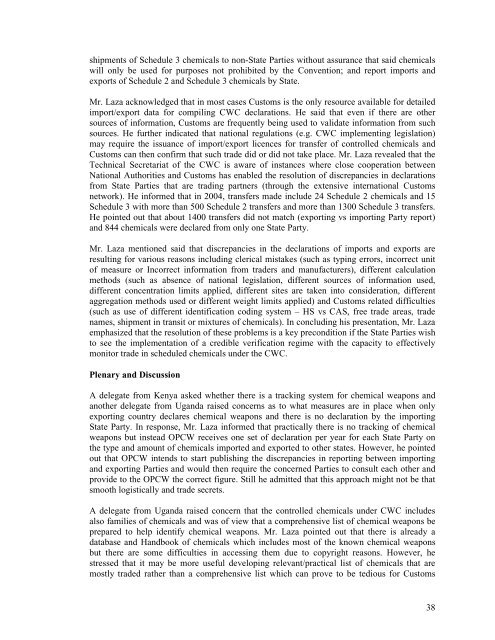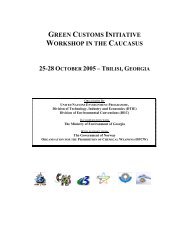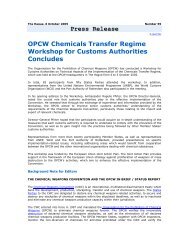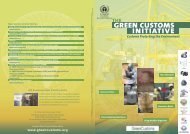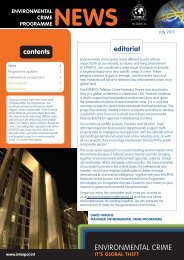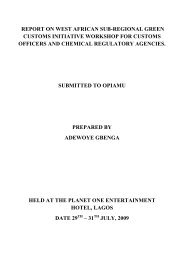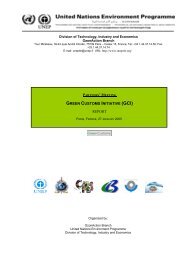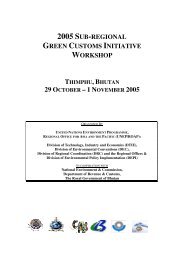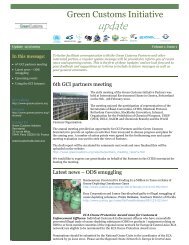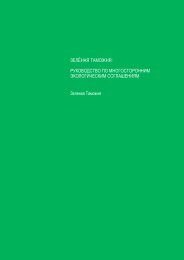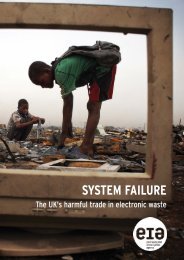Arusha - Green Customs Initiative
Arusha - Green Customs Initiative
Arusha - Green Customs Initiative
Create successful ePaper yourself
Turn your PDF publications into a flip-book with our unique Google optimized e-Paper software.
shipments of Schedule 3 chemicals to non-State Parties without assurance that said chemicals<br />
will only be used for purposes not prohibited by the Convention; and report imports and<br />
exports of Schedule 2 and Schedule 3 chemicals by State.<br />
Mr. Laza acknowledged that in most cases <strong>Customs</strong> is the only resource available for detailed<br />
import/export data for compiling CWC declarations. He said that even if there are other<br />
sources of information, <strong>Customs</strong> are frequently being used to validate information from such<br />
sources. He further indicated that national regulations (e.g. CWC implementing legislation)<br />
may require the issuance of import/export licences for transfer of controlled chemicals and<br />
<strong>Customs</strong> can then confirm that such trade did or did not take place. Mr. Laza revealed that the<br />
Technical Secretariat of the CWC is aware of instances where close cooperation between<br />
National Authorities and <strong>Customs</strong> has enabled the resolution of discrepancies in declarations<br />
from State Parties that are trading partners (through the extensive international <strong>Customs</strong><br />
network). He informed that in 2004, transfers made include 24 Schedule 2 chemicals and 15<br />
Schedule 3 with more than 500 Schedule 2 transfers and more than 1300 Schedule 3 transfers.<br />
He pointed out that about 1400 transfers did not match (exporting vs importing Party report)<br />
and 844 chemicals were declared from only one State Party.<br />
Mr. Laza mentioned said that discrepancies in the declarations of imports and exports are<br />
resulting for various reasons including clerical mistakes (such as typing errors, incorrect unit<br />
of measure or Incorrect information from traders and manufacturers), different calculation<br />
methods (such as absence of national legislation, different sources of information used,<br />
different concentration limits applied, different sites are taken into consideration, different<br />
aggregation methods used or different weight limits applied) and <strong>Customs</strong> related difficulties<br />
(such as use of different identification coding system – HS vs CAS, free trade areas, trade<br />
names, shipment in transit or mixtures of chemicals). In concluding his presentation, Mr. Laza<br />
emphasized that the resolution of these problems is a key precondition if the State Parties wish<br />
to see the implementation of a credible verification regime with the capacity to effectively<br />
monitor trade in scheduled chemicals under the CWC.<br />
Plenary and Discussion<br />
A delegate from Kenya asked whether there is a tracking system for chemical weapons and<br />
another delegate from Uganda raised concerns as to what measures are in place when only<br />
exporting country declares chemical weapons and there is no declaration by the importing<br />
State Party. In response, Mr. Laza informed that practically there is no tracking of chemical<br />
weapons but instead OPCW receives one set of declaration per year for each State Party on<br />
the type and amount of chemicals imported and exported to other states. However, he pointed<br />
out that OPCW intends to start publishing the discrepancies in reporting between importing<br />
and exporting Parties and would then require the concerned Parties to consult each other and<br />
provide to the OPCW the correct figure. Still he admitted that this approach might not be that<br />
smooth logistically and trade secrets.<br />
A delegate from Uganda raised concern that the controlled chemicals under CWC includes<br />
also families of chemicals and was of view that a comprehensive list of chemical weapons be<br />
prepared to help identify chemical weapons. Mr. Laza pointed out that there is already a<br />
database and Handbook of chemicals which includes most of the known chemical weapons<br />
but there are some difficulties in accessing them due to copyright reasons. However, he<br />
stressed that it may be more useful developing relevant/practical list of chemicals that are<br />
mostly traded rather than a comprehensive list which can prove to be tedious for <strong>Customs</strong><br />
38


